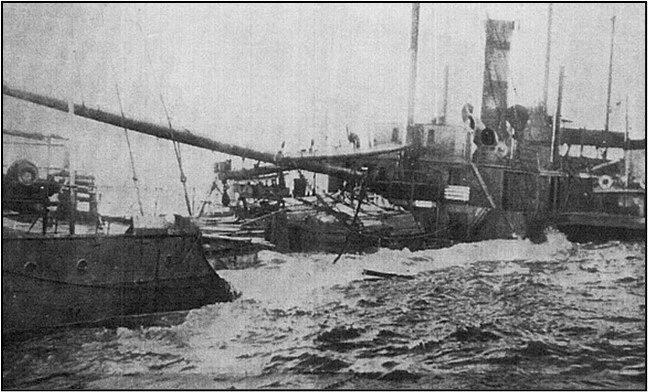December 1941: Japanese submarine torpedoes ships off San Pedro by Jim Shneer
December 1941: Japanese submarine torpedoes ships off San Pedro
by Jim Shneer
After the attack on Pearl Harbor on December 7, 1941, nine of the twelve Japanese submarines positioned in Hawaiian waters prior to the attack were ordered to the U.S. Pacific coast to attack merchant shipping. These submarines, all similar, had a range of about 14,000 miles at 16 knots (about 18½ mph), a maximum surface speed of about 23½ knots, could carry up to 17 torpedoes, a seaplane stored in a watertight hangar and had a 5.5" deck gun. Based on pre-war intelligence, the submarines were assigned areas along the coast as shown in the accompanying map. From December 18th through December 24th these submarines attacked eight merchant ships sinking two, damaging two and killing 6 crew members.
On December 24, Lieutenant Commander Narahara Shogo's I-19 launched a torpedo at the lumber ship Barbara Olson near the entrance to the Port of Los Angeles. The torpedo ran under the ship at 06:25, but the plume from the exploding torpedo alerted the 350-ton submarine chaser USS Amethyst which pursued I-19 unsuccessfully.
1943 photograph of I-19 (wikipedia)
1943 photo of the USS Amethyst (PYC-3) Submarine chaser (National Archives photo 80-G-457673)
At 10:40, west of Point Fermin, I-19 fired two torpedoes at the 5,695 ton freighter Absaroka operated by the McCormack Steamship Co. with a cargo of lumber. The first torpedo missed but the second struck the freighter at the No. 5 hold, causing extensive damage and blowing the cargo from the hold into the air killing one crew member, Joseph Ryan, who was crushed by a wall of displaced lumber as it and he were thrown overboard. Captain Pringle then ordered a radioman Walt Williams to send out a distress call indicating that they had been torpedoed. At this time, the crew took to the lifeboats but stood by the ship.
May 31, 1941 photograph of the Absaroka (U.S. Coast Guard)
Absaroka listing after torpedo strike (U.S. Navy)
Absaroka awash (LA Examiner via Don Young)
Not long after Williams' distress call, U.S. planes bombed near where the sub was last seen and shortly thereafter Amethyst arrived and began dropping depth charges. Despite the efforts to retaliate against I-19, neither the bombs nor the 32 depth charges showed any results.
Later in the day, seven of the 33-man crew including Captain Pringle came back onboard. And, seeing that the ship was not in any immediate danger of sinking, a U.S. Navy tug under the command of Lt. Commander Hans B. Olson took Absaroka in tow and beached her on a strip of sand below Fort MacArthur.
On December 27th, with their fuel reserves running low, Vice Admiral Shimizi recalled the submarines to refuel at Kwajalein Island in the Marshall Islands.
Early January photo of Absaroka in dry dock (LA Times via Don Young)
A month later, in the January 26, 1942, issue of LIFE magazine, movie actress Jane Russell appeared in the full-page "Picture of the Week" standing in the hole in Absaroka's side created by the Japanese torpedo. In the picture she is holding a poster that warns: "A slip of the lip may sink a ship," with the words "may sink a ship" crossed out and the words "may have sunk this ship" written in.
Jane Russell aboard the Absaroka (Life Magazine)
Jim is a former aerospace engineering manager who, since retiring, has become an author and speaker on a variety of military subjects. To read more about his work, please visit https://easyreadernews.com/the-battle-that-didnt-happen/. To learn about the military history of Fort MacArthur and Palos Verdes, please visit http://www.lulu.com/shop/james-shneer/exploring-the- military-history-of-fort-macarthur-and-palos-verdes/paperback/product-23784472.html to purchase a copy of his recent book.









